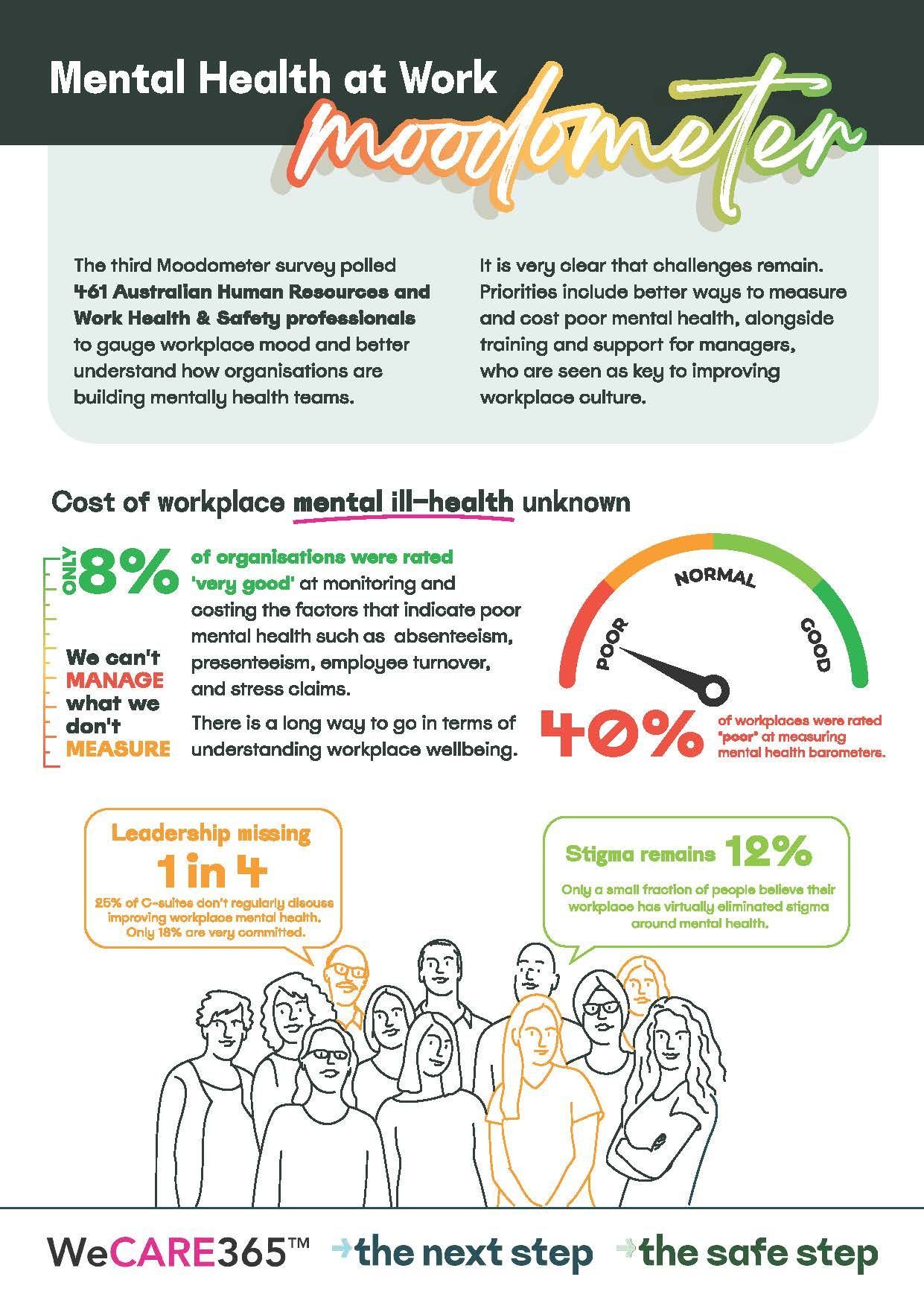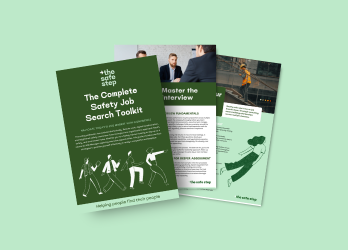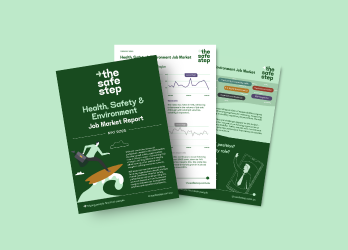Mental Health at Work Moodometer
Page Published Date:
April 4, 2023
The third Moodometer survey polled 461 Australian WHS and HR professionals to measure the mood of their workplace and better understand how workplace mental health is being managed. Some of the results were disturbing.
Read on to learn how organisations fare when it comes to costing, managing and supporting positive mental health in the workplace, or download a copy of the report below.
Mental health not measured
Of cause for concern, 40% of survey respondents said their organisation was 'poor' at measuring indicators of poor mental health within the workforce. Only a tiny 8% of leadership teams were judged 'very good' at monitoring and costing the factors that indicate poor mental health, such as absenteeism, presenteeism, employee turnover, stress claims etc.
Mental health author and advocate Graeme Cowan believes that having systems and processes to track key indicators is essential for complying with new work and health safety laws. "You can't manage, what you don't measure," he says. "This is about to become a much bigger problem if organisations aren't doing it right."
From April 1st WHS laws employers across most regions of Australia will be responsible for measuring risks including stress, bullying, harassment and work-related violence that can impact mental health and wellbeing of employees.
Aaron Neilson, CEO of The Safe Step, believes a greater emphasis in workplace wellbeing will create new opportunities for work health and safety professionals. “Organisations are beginning to invest in AI to consolidate workplace data. We’re also seeing an increased demand for tech-savvy HR and HSE professionals who can analyse information and convert numbers into meaningful insights,” he said.
Managers need extra support
An alarming 44% of people say that most managers within their organisation don’t know how to build a mentally healthy team.
When asked what organisations could do to improve or better support positive workplace mental health, a number of respondents identified providing specialist training and support to managers as being key.
"Provide more guidance to our supervisors and managers to handle and support employees," suggested one survey respondent. A sentiment echoed by many (see additional comments below).
Stigma clouds the issue
Only a small fraction of people (12%) believe their workplace has virtually eliminated stigma around mental health. Meanwhile nearly a quarter of respondents (24%) report that they encounter mental health stigma at work.
They key to removing stigma? Education and open communication, with an emphasis on listening believe many survey respondents. "Normalising the conversation and not judging those struggling with mental health," suggested a surveyee. "Listen to those who speak up and not isolate them or fear them," adds another.
Workplace mood suffers
According to the Moodometer survey, the average mood of organisations was rated at 59/100 but disturbingly a third of employees scored their organisation below 50, and 5% said their workplace was toxic, dysfunctional, and ineffective.
Workplace mental health is taking an increased importance. “Large organisations are creating Chief Mental Health Officer (CMHO) positions and we’ve seen an exponential rise in demand for evidence-based Wellbeing professionals,” said Aaron Neilson.
How to improve mental health at work
Listen and request 360 degree feedback
- "Improve the culture of feedback (receiving and giving feedback)."
- "Use 2 ears and 1 mouth in proportion."
- "Gemba walking"
- "Check-ins to ask how people are and acting upon red flags."
Provide fair, manageable, sustainable work
- "Constantly assess workloads for efficiency effectiveness and sustainability"
- "Not glorify those that work long hours"
- "Stop letting people go and creating unrealistic workloads for those left behind."
- “Adjust the operating model and financial targets to reflect the market conditions and recognise the staff shortages, war for talent and increased levels of fatigue and sick leave.”
Communicate, educate & resource mental health initiatives
- “[Have] focused and guided conversations about mental health and wellness.”
- "Understand [mental health] is a priority and invest in education and prevention rather than just paying for psych support to pick up the pieces at the end!"
- “More awareness building and authentic sharing. Promoting mental health days.”
- “Senior Leadership could discuss the issues more openly with staff, rather than just at leadership team level.”
- “Communicating that mental health matters and on a practical level [have] the supports and assistance available... for employees who may need further help or support; and a consistent reminder to them on how and where they can obtain help.”
Provide mental health training for managers & staff
- “Conduct mandatory training on this important subject (as a start).”
- "Invest in building people leader capability, specifically inclusion and early intervention,"
- "Provide more guidance to our supervisors and managers to handle and support employees."
- "Train managers to spot those who may be struggling."
Remove toxic influences from the organisation
- “Hold all Leaders accountable and not accept poor behaviours.”
- “Be prepared to walk away from profitable workplace partnerships that create negative mental health stresses.”
- “Manage poor performance and conduct.”
- “Get rid of a Narcissistic CEO.”
- “Our Board of Directors have double standards and a negative impact on the executive.”
Taking a planned, systematic approach
- “[We] need clearer strategy and plans, review which work is valuable, the team can tell you what work should stop.”
- “Mental Health issues can strike anyone at any time. Systematic mental health and resilience programs are fundamental.”
- “Focus on the areas in the organisation where we know, from surveys, that people are under stress.”
- “Clearer direction, prioritisation and less frantic, reactivity.”
- “A structured Wellness Plan and a budget for it.”
Other ways to support mentally healthy workplaces
- Provide paid mental health/wellbeing leave
- Approach the issue with genuine care/make it personal (not about numbers)
- Measure & analyse mental health indicators
- C-suite priority & alignment
- Provide flexible, autonomous work
- Create more quality face-to-face time for teams
- Role modelling from senior leaders
- Subsidised/free/fast access for professional help
- Fix pain-points within the organisation
- Logical, transparent decision making
- Take a wholistic view - body, mind & spirit
- Reflect on the wins/have fun at work
- Permanent roles/secure work
How we can help
Has your health and safety team got the capabilities and experience to manage workplace mental health? As Australia’s leading recruitment and search consultancy specialising in Health, Safety, Environment and Wellbeing, we can connect you with wellbeing specialists on either a permanent or temporary project basis.
Or, if you need support framing a new evidence-based wellbeing initiative, our expert consultants can scope the project, identify your resourcing needs and connect you with the right HSE people to deliver with impact.
To discuss requirements please contact our team via your closest Safe Step Office, or on 1800 573 377





